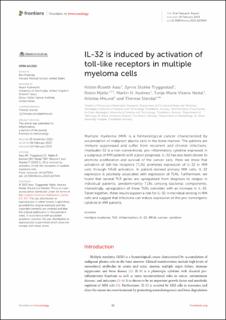| dc.contributor.author | Aass, Kristin Roseth | |
| dc.contributor.author | Tryggestad, Synne Stokke | |
| dc.contributor.author | Mjelle, Robin | |
| dc.contributor.author | Kastnes, Martin Haugrud | |
| dc.contributor.author | Nedal, Tonje Marie Vikene | |
| dc.contributor.author | Misund, Kristine | |
| dc.contributor.author | Standal, Therese | |
| dc.date.accessioned | 2023-10-31T06:28:07Z | |
| dc.date.available | 2023-10-31T06:28:07Z | |
| dc.date.created | 2023-04-11T09:47:42Z | |
| dc.date.issued | 2023 | |
| dc.identifier.citation | Frontiers in Immunology. 2023, 14 . | en_US |
| dc.identifier.issn | 1664-3224 | |
| dc.identifier.uri | https://hdl.handle.net/11250/3099541 | |
| dc.description.abstract | Multiple myeloma (MM) is a hematological cancer characterized by accumulation of malignant plasma cells in the bone marrow. The patients are immune suppressed and suffer from recurrent and chronic infections. Interleukin-32 is a non-conventional, pro-inflammatory cytokine expressed in a subgroup of MM patients with a poor prognosis. IL-32 has also been shown to promote proliferation and survival of the cancer cells. Here we show that activation of toll-like receptors (TLRs) promotes expression of IL-32 in MM cells through NFκB activation. In patient-derived primary MM cells, IL-32 expression is positively associated with expression of TLRs. Furthermore, we found that several TLR genes are upregulated from diagnosis to relapse in individual patients, predominantly TLRs sensing bacterial components. Interestingly, upregulation of these TLRs coincides with an increase in IL-32. Taken together, these results support a role for IL-32 in microbial sensing in MM cells and suggest that infections can induce expression of this pro-tumorigenic cytokine in MM patients. | en_US |
| dc.language.iso | eng | en_US |
| dc.publisher | Frontiers | en_US |
| dc.rights | Navngivelse 4.0 Internasjonal | * |
| dc.rights.uri | http://creativecommons.org/licenses/by/4.0/deed.no | * |
| dc.title | IL-32 is induced by activation of toll-like receptors in multiple myeloma cells | en_US |
| dc.title.alternative | IL-32 is induced by activation of toll-like receptors in multiple myeloma cells | en_US |
| dc.type | Peer reviewed | en_US |
| dc.type | Journal article | en_US |
| dc.description.version | publishedVersion | en_US |
| dc.source.pagenumber | 0 | en_US |
| dc.source.volume | 14 | en_US |
| dc.source.journal | Frontiers in Immunology | en_US |
| dc.identifier.doi | 10.3389/fimmu.2023.1107844 | |
| dc.identifier.cristin | 2139853 | |
| dc.relation.project | Norges forskningsråd: 223255 | en_US |
| dc.relation.project | Samarbeidsorganet mellom Helse Midt-Norge og NTNU: 90171600 | en_US |
| dc.relation.project | Norges forskningsråd: 274991 | en_US |
| dc.relation.project | Samarbeidsorganet mellom Helse Midt-Norge og NTNU: 90635300 | en_US |
| dc.relation.project | Kreftforeningen: 198161 | en_US |
| dc.relation.project | Samarbeidsorganet mellom Helse Midt-Norge og NTNU: 30171600 | en_US |
| cristin.ispublished | true | |
| cristin.fulltext | original | |
| cristin.qualitycode | 1 | |

